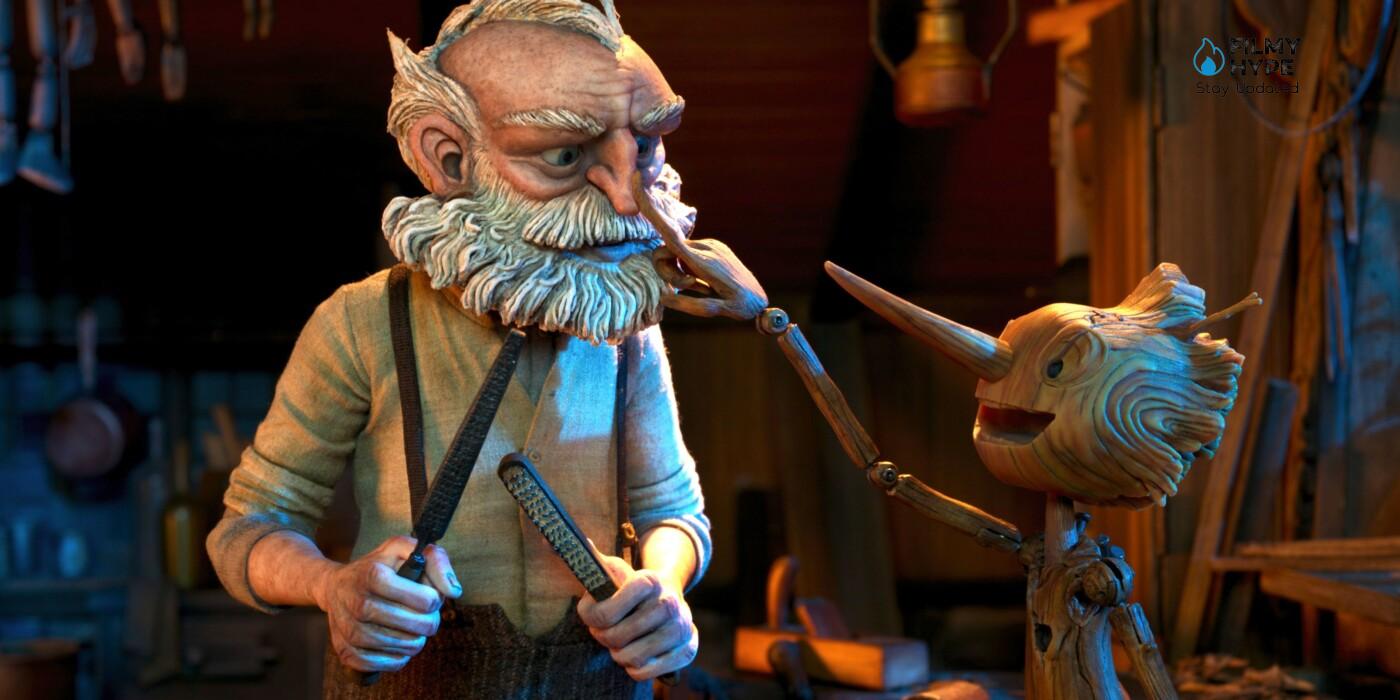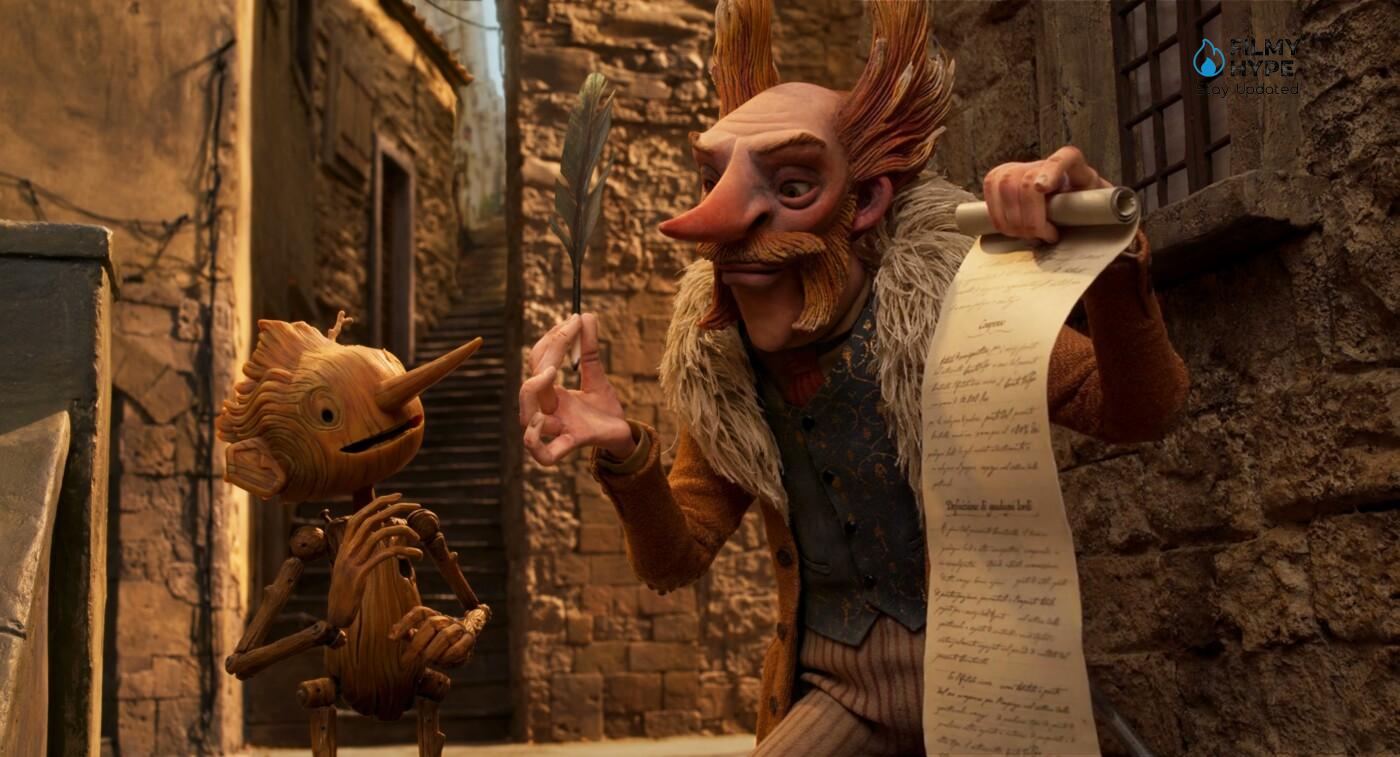Guillermo del Toro’s Pinocchio Review: Guillermo Turns Collodi’s Story Upside Down an Animated Jewel On Netflix
Stars: Ewan McGregor, David Bradley, Gregory Mann
Director: Guillermo Del Toro
Streaming Platform: Netflix
Filmyhype.com Ratings: 4/5 (four stars)
Guillermo del Toro’s Pinocchio is a unique and precious authorial vision, a peculiar declination of a great classic of literature that has been re-proposed for too long in not very brave cinematic sauces (read the review of the Disney live-action Pinocchio). The one that finally arrives streaming on Netflix after the first pass in theaters is an animated film of astonishing beauty and intensity. in which del Toro’s artistic sensibility joins the excellent direction of co-director Mark Gustafson, in an extremely memorable and particular work.

“He is made of wood, like me. Why does everyone love him and everyone hates me?”. Talking is Pinocchio, a wooden puppet, while, in a church, he looks at a crucifix. This a legitimate question, from his point of view. Yet no one, in decades of adaptations of Collodi’s famous novel, had ever stopped doing it. It is from these details that we understand what kind of film it is that we tell you in the review of Pinocchio by Guillermo Del Toro, a stop-motion animated jewel, streaming on Netflix from December 9th. Guillermo Del Toro’s Pinocchio is courageous, nonconformist, and anti-fascist and, for the first time, he rereads the story of the puppet with an approach that is not the usual guilt-inducing way. It is an important novelty, on a conceptual level, which joins a magical film from a visual point of view. A dark fairy tale not for children, but for adults, to see.
Guillermo del Toro’s Pinocchio Review: The Story
Gullermo Del Toro’s Pinocchio is set in the Italy of the 1930s, that of fascism, in a town where the Duce’s effigies are all over the walls, and the priest and the podestà, a fascist hierarch, are in charge. Pinocchio is created by Geppetto, who has just lost a son and believes in this way to replace him. But, while Geppetto realizes that he cannot be the child who is no longer there, the priest and the fascist see Pinocchio as a “dissident”, a “free thinker”. The story of the iconic wooden puppet has been told in so many ways, all of which are quite similar to each other. It is therefore important that the vision of del Toro and Gustafson emerges in an ocean, at least recently, of great creative flattening.
Netflix’s new Pinocchio is faithful only from the outset to the original material by Carlo Collodi, and in any case, it takes up some classic stylistic features – characters and general situations – to set up a parable about the family, but also about death and even politics, which it will only amaze older audiences, but it could even throw off those who expected a simple family film. From the beginning, the plot emphasizes some of the darkest themes that were vaguely hinted at even in the first work from the superfine pen of Collodi: the loneliness of Geppetto, a father torn apart by the pain of an unspeakable loss and slowly slipped into a paranoid and dangerous depression, following which he decides to create an artificial child by obtaining it from the wood of a pine that caused him too many dramatic memories.
Thanks to the magic of a supernatural entity, the puppet that comes to life is a lively child looking for his place in the world, trying to become a better person and follow the teachings of his grumpy father, still too devastated by the ghosts of his past. The structure of the story proceeds on classical tracks only up to a certain point, until the epic story of little Pinocchio and his companion conscience, the Jiminy Cricket, takes a drift that only partially follows the original novel while keeping faith with the main trappings of the mother story.
Guillermo del Toro’s Pinocchio Review and Analysis
We won’t list the differences and changes that del Toro’s Pinocchio makes concerning the source material, also to leave you to the pleasure of discovery and the many messages that the Netflix film contains. What we can tell you is that Pinocchio represents a unique approach to the character, telling a parable that exploits the main topoi of the literary classic to develop a much broader and more stratified discourse. Pinocchio is a surprisingly political film, but also profound about its reflections on life and death, all cloaked in a vaguely gothic vein that cleverly alternates with the lighter moments of the film.
A story wrapped in a dark fantasy frame, moreover, which declines the supernatural aspects of the story in surprising and unexpected ways, even hooking up to a historical realism that not only amazes but even adheres perfectly to the tones of the feature film and the themes narrated by Collodi in his work. A formula well supported by sublime animation, halfway between digital technique and stop motion, varied from a chromatic point of view and enriched by convincing photography. The flagship, aforementioned visual sector, of a delightful, profound and moving work, that even dares to add a significant change to the epilogue of the original story that does not affect the final message of the adventure. A film, in this, is also very melancholic and emotional: a real jewel, which embellishes the Netflix film catalog and adds another splendid gem of animation on the American streaming platform.

But Guillermo Del Toro overturns Collodi’s tale and all those who, so far, have been adaptations of Pinocchio. Who had always shown, consistently in the book, Pinocchio as the naughty, fragile child, the one for whom it was easy to fall into temptation, the one who abandoned the right path and was always punished? Here it is the others who put Pinocchio in the most uncomfortable situations. Here it is Geppetto asking Pinocchio to be someone he is not. It is the father who tells his son that he is a burden, a burden, and in this way he pushes him away. It is as if Del Toro’s film wanted to tell us that there are no bad children, only parents who are not good enough. Finally, after more than one hundred years, Pinocchio is no longer the child to whom he had always been drawn. He’s a good guy, one who gives it his all. And finally, after so many years.
Visually, Pinocchio is a visionary, dark and original work. The stop motion technique is evident, and the jerky movements typical of this technique look perfectly like the erratic movements of a wooden puppet. But, looking at the figures of Pinocchio, one has a sense of the material. It almost seems to be able to touch those characters who are treated as if they were really – puppets and not – carved in wood. The more picaresque parts make us think, at times, of Pirates! Off-the-beaten-path brigands, by Aardman. The darker and more macabre ones are in the works of Tim Burton and Henry Selick. In any case, they are excellent in the field of stop motion. And anyway, after all, Del Toro’s Pinocchio doesn’t look like anything that’s ever been done. Guillermo Del Toro confirms himself as a fantastic creator of fantastic creatures. His Pinocchio is an anti-fascist story, as Pan’s Labyrinth was anti-Franco and his Hellboy anti-Nazi. Del Toro still fights against totalitarianism, dictatorships, and abuses of power. Pinocchio is a film full of gimmicks (above all the nose which, as it stretches, becomes a real tree). It is a visionary, macabre and political film.
Guillermo del Toro’s Pinocchio Review: The Last Words
Pinocchio by Guillermo del Toro and Mark Gustafson is an intelligent, authorial and virtuoso reinterpretation of the Collodi classic. An exciting, dark and even political animated film that rewrites the original work with convincing ideas and a dark fantasy frame cloaked in interesting historical realism. A pearl of “woody” beauty, which courageously reworks a story that needed to be reinterpreted with conviction. As we told you in the review of Pinocchio, Guillermo Del Toro’s film is courageous, nonconformist, and anti-fascist and rereads the story of the puppet with an approach that is not the usual guilty way. It’s a visually magical film. A dark fairy tale not for children, but for adults, to see.







